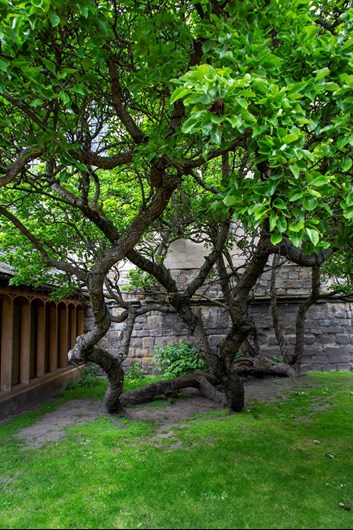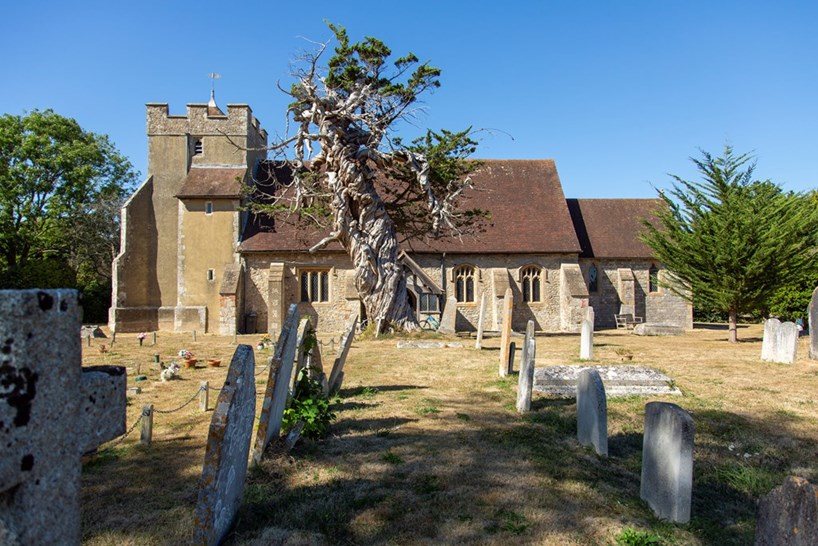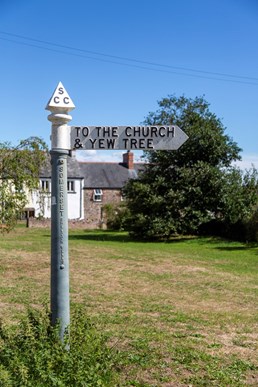FOR many, the felling of the Sycamore Gap tree in September 2023 marked a low ebb in society’s respect for trees, but the outpouring of grief and public interest showed how many of us care deeply about the fate and condition of our trees.
Remarkable and historic trees — many known only to those who live near them — can be found throughout the UK and often have fascinating stories. But, while the National Trust was the landowner at the Northumbrian Sycamore Gap site, it is the Church that is the most important custodian of our great heritage trees.
 Paul WoodThe pear tree (Pyrus communis), the Ecclesiastical Pear, growing against the wall of Hexham Abbey
Paul WoodThe pear tree (Pyrus communis), the Ecclesiastical Pear, growing against the wall of Hexham Abbey
From cathedrals to parish churches, churchyards, closes, and gardens have become refuges for ancient and unusual trees. They are timeless settings where trees have resided for centuries and, in a few examples, churches have arrived after the trees.
The evergreen yew tree is most associated with churches, and the most exceptional specimens of this extremely long-lived species can be found in churchyards. Indeed, the oldest tree in Britain is a churchyard yew. This particular example — the Fortingall Yew — can be found in a remote Scottish village and is thought to be thousands of years old. It is a series of living fragments, as many very old yews are, now protected in its own walled enclosure next to the church. It comes with a fascinating legend to hint at its great age.
Pontius Pilate, so the story goes, later governor of Judaea, was born in Fortingall when his father, a Roman diplomat, was on a mission to a Scottish tribe. It is said that, as a child, Pilate played under the boughs of the yew, which would have been an ancient landmark even then, centuries before the first church was built here.
The Fortingall tree might be regarded as an outlier because it is in Scotland, as the greatest concentration of very old yews grows in England and Wales. There are dozens of trees whose ages seem to approach that of the Scottish tree. Like it, they are frequently a collection of collapsing shards. These ancient remnants pose problems for scholars, though: they are almost impossible to date accurately. But through observation, comparison, and historic documents, we have begun to understand how old these trees might be. It is what is missing that determines great age: if a tree has a large void between fragments, and those fragments describe a large circumference, then that is the effect of thousands of years of growth.
CHURCHYARD yews have attracted people’s attention and fired their imaginations for centuries; so early records can often help to determine their longevity. There is a tree on the Isle of Wight which appears in a print dated 1567. It grows in the churchyard of St Mary’s, Carisbrooke — a handsome church with Norman foundations. The tree appears to be a relative youngster: it has none of the hollowing or voids of a very old tree, and yet it is entirely likely that this tree is hundreds of years old and could be contemporary with the church.
An even older yew can be found on the Wirral in Cheshire. This corpulent old tree, fatter than its cousin in the south, but not yet fragmented, grows in the churchyard at St Mary’s, Eastham. Remarkably, it was mentioned in 1152 when, as a sign on the tree’s protecting railings states, “the Abbot and Monks of St Werburgh received the Manor of Eastham at the hand of Earl Randall of Chester, the villagers of Eastham entreated the new owners ‘to have a care of ye olde yew’”. Those medieval parishioners were surely concerned for a landmark tree that had been the familiar backdrop to the lives of generations of villagers.
 Paul WoodThe Mediterranean cypress tree (Cupressus sempervirens) at Birdham, planted, according to legend, by a returning crusader at St James’s. It succumbed to a storm in 2024
Paul WoodThe Mediterranean cypress tree (Cupressus sempervirens) at Birdham, planted, according to legend, by a returning crusader at St James’s. It succumbed to a storm in 2024
One of the oldest yews in England was mentioned in passing by the 18th-century naturalist the Revd Gilbert White, the author of The Natural History and Antiquities of Selborne, who recorded a yew tree at St Mary’s Selborne, which has subsequently been lost. He was also a curate at All Saints’, in the neighbouring village of Farringdon. While the Farringdon tree does not appear in his Natural History, White did note in his diary that the tree had a girth of 30 feet in 1781. In 2025, its girth — which encloses a significant hollow — is unchanged, adding weight to the theory that this is a very old tree indeed.
White’s yew at Farringdon pales in comparison with a tree that has a good claim to being England’s oldest. Another hollow tree consisting of half a dozen stems describing an even larger circumference can be seen at St John the Baptist, Ashbrittle, in Somerset. The 13th-century church that it grows beside has a spring below its altar, and the tree — thought to be thousands of years old — grows on a Bronze Age burial mound. These features point to this location as being an important, even spiritually important, site for a long time. The church is the latest confirmation of its significance.
It seems that we humans have long revered the yew tree, recognising it as a symbol of long life, and, because it is evergreen, of everlasting life. Its evergreenness would have been almost unique among trees in Britain centuries ago: our other native evergreens, the juniper and holly, are smaller, and Scots pine would once have been restricted to remote uplands. Large evergreen yew trees would have made significant landmarks, and because they are poisonous, their planting would have been limited to sites where animals did not graze. It was an ideal tree to mark an important place.
WHILE the yew has long been associated with churches, it is not the only species to have found refuge on religious sites. Nearly every church will have trees growing near by. Even if these are not as ancient as some of our yews, they may still be landmarks, conspicuous for their size, their shape, or even some dramatic seasonal variation, such as spring flowers or autumnal leaf colour. It is these less expected trees that can sometimes tell intriguing stories or cause the greatest surprise.
As the centuries have passed, inquisitive people have ventured further afield and returned home with an ever greater variety of exotic species, trophies of travel to far-away places. As modes of transport have become faster and more efficient, the plants that have arrived, particularly since the 19th century, have become increasingly diverse.
 Paul WoodThe Mediterranean cypress tree (Cupressus sempervirens) at Birdham, planted, according to legend, by a returning crusader at St James’s. It succumbed to a storm in 2024
Paul WoodThe Mediterranean cypress tree (Cupressus sempervirens) at Birdham, planted, according to legend, by a returning crusader at St James’s. It succumbed to a storm in 2024
Until 2024, when, in a wizened state, it finally succumbed to a storm, what some claimed to be the first example of a Mediterranean cypress tree to arrive in Britain grew in the West Sussex churchyard of St James’s, Birdham. It has been suggested that the tree, or the seed from which it sprang, was brought back from the Holy Land by a returning Crusader hundreds of years ago. At a time when yews would have been the only conifer known to most people, it must have made St James’s a particularly distinctive churchyard.
In Staffordshire, a veteran oak takes the place of an ancient yew at St Mary’s, Castle Church. It is a magnificent tree, several hundred years old, and puzzling to see in such a location. Similarly aged oaks might normally be associated with woodland or parklands, but oaks are rarely found in an ecclesiastical setting.
Further north, another puzzle awaits at Hexham Abbey, where a sprawling pear tree grows close against the church’s southern wall. While pears are not particularly long-lived trees, they are often pruned, a practice that can extend their lives; so there is a possibility that this tree is a remnant from what was once a cloister garth.
 Paul WoodSignpost to the Ashbrittle Yew, one of England’s oldest trees.
Paul WoodSignpost to the Ashbrittle Yew, one of England’s oldest trees.
Few cloisters survived the Reformation except in our magnificent cathedrals. At Salisbury, a pair of soaring cedars of Lebanon are enclosed within the sheltered cloister. This location has allowed the trees to grow particularly tall, so that they can be seen by those admiring the cathedral’s west front from the Close. Interestingly, we know that the cedars were planted in 1837 to mark the accession of Queen Victoria to the throne. It is hard to imagine the cloister today without them, but presumably this was a treeless enclosure in centuries past.
Another cedar of Lebanon — this one planted in 1803 (in fact we know it was planted on 25 March by the Dowager Countess Spencer) — can be seen at St Albans Cathedral, growing in a more open situation next to the Chapter House. Over 22 decades, it has not grown as tall as the Salisbury trees, but has taken on a dramatic and characterful shape that has endeared it to many thousands of worshippers and visitors.
Our churchyards have proved to be ideal tree nurseries. Often protected and sensitively managed, the great treasures that reside there are an important part of our national heritage. But vandalism — of old yew trees, in particular — is a constant threat, and, as climate changes, the pressures on trees will change, too. Today, though, scores, if not hundreds, of tree species grace our church landscapes. As individual trees of ever more diverse species become older and more distinctive, they will come to define them in the future as much as the miraculous yew trees have for millennia.
Paul Wood is an urban tree specialist and the author of Tree Hunting: 1,000 Trees to find in Britain and Ireland’s towns and cities, published by Particular Books at £30 (Church Times Bookshop £27); 978-0-241-50205-1. It gives details of dozens of trees growing in churches throughout the UK and Ireland.
















